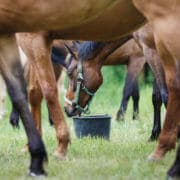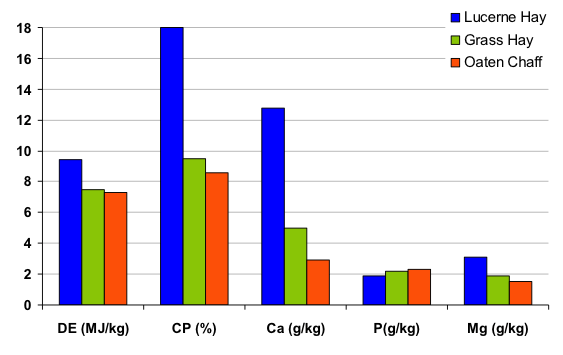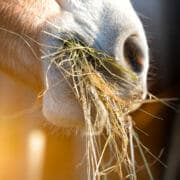Grains for Horses: Cooked or Uncooked?
While a lot of time is spent focussed on horses that can’t eat grain in their diet, cereal grains such as oats, barley, triticale, corn, rice, rye, sorghum and wheat form a valuable component of many horse’s rations. Selecting the most digestible grain-based feed however can be confusing, with uncooked grains like whole, cracked and crushed grains being available as well as cooked grains like extruded, micronised, steam rolled, or steam flaked and pelleted grains.
The question is, which form of grain is best for your horse, cooked or uncooked?
Why we cook grains
Grains are fed primarily as a source of energy in a horse’s diet and that energy is derived mainly from the white starch found in the centre of the grain. For the horse to obtain the energy from the starch it must be digested by enzymes in the small intestine.
But digesting the starch to extract the energy is not easy for the horse because it is “packaged” within the grain in a way that makes it difficult for the horse to get to. The reason grains are cooked is to make access to the starch a lot easier for the horse.
How starch is “packaged”
Starch is simply many glucose molecules all bonded together and bundled up into starch granules. These starch granules are then embedded amongst protein in a structure known as the protein matrix (Figure 1).
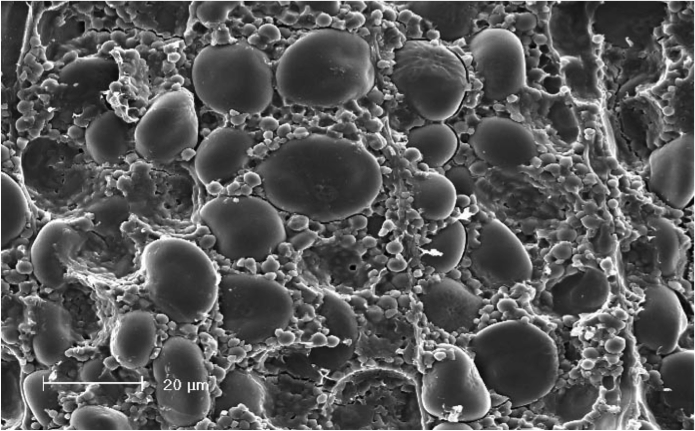
Figure 1: A scanning electron micrograph of the middle of a barley grain showing the starch granules embedded within the protein matrix. The starch granules are the large round objects.
The starch granules, embedded in the protein, are then encased within individual endosperm cells and protected by a cell wall. Many of these cells are packed tightly within the grain’s starchy endosperm (the white bit found in the middle of a grain). And the endosperm itself is protected by the aleurone layer and finally the entire structure is covered by the seed coat (Figure 2). Now from the plant’s perspective, all of this packaging is absolutely critical for its survival and is designed to protect the plant embryo and its stored sources of energy and protein to ensure it will be able to grow and survive for the first few days following germination.
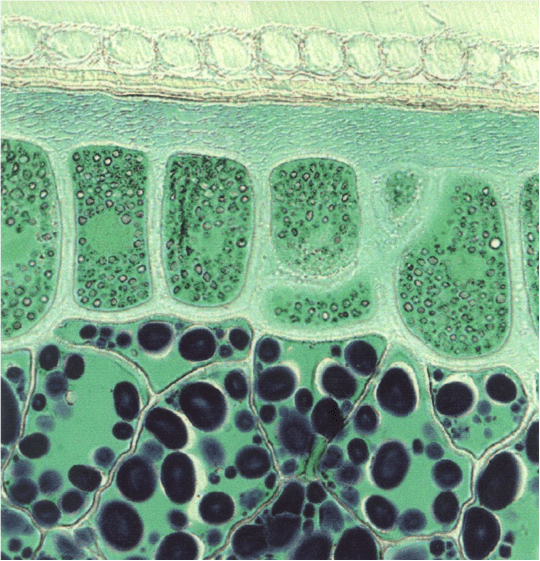
Figure 2: The location of starch granules (stained black) within the endosperm cells of barley grain surrounded by the protein matrix (stained green) and protected by the aleurone layer and seed coat.
So, the packaging is clever and essential from the plant’s perspective, however for the horse, all of this packaging is just a nuisance and prevents the horse from being able to digest and extract the energy from the grain. In fact, this packaging was actually specifically designed to allow a grain to pass through the gastrointestinal tract of an animal undamaged so it may germinate when it is excreted in the manure.
How does this packaging stop starch digestion?
The packaging can be likened to a security system at a casino which prevents the thieves (or in this case the enzymes) from stealing the cash (the starch). To digest the starch the enzymes in the horse’s small intestine must first breech the seed coat, then penetrate the aleurone layer. Following this they need to be able to make their way through the endosperm cell walls (these are the cells that contain the starch), then burrow through the sometimes impenetrable vault of the protein matrix before finally reaching the starch granule. Then, in a cruel twist of fate, if the enzyme reaches this far, it will find that the starch is bundled so tightly into a ball that the enzymes cannot digest it. So, the horse is presented with a difficult hurdle—just how does it go about extracting the energy held in the starch of cereal grains?
Enter cooked grains…
It has been recognised for many years now that to effectively digest cereal grains, horses need some help. And that help comes in the form of ‘cooking’. Cooking grains using processes like extrusion, micronising and steam flaking breaks down the barriers the enzymes have to face in reaching and digesting cereal grain starch.
How cooking helps
When grains are cooked using a combination of heat, moisture, pressure and some form of physical process like rolling or grinding, the entire structure of the grain is disrupted. To start, the seed coat and aleurone layer are broken and the endosperm cell walls are opened up. In addition, the structure of the protein matrix is physically disrupted so it is no longer able to protect the starch granules. Cooking also turns the ordered and tightly packed structure of the starch granule into an open and vulnerable structure which can be easily attacked by enzymes in a process known as gelatinisation. Cooking simply gives the horse’s enzymes access to the grain starch so they can go about their work of cutting up the starch into single glucose molecules, which the horse then absorbs from the small intestine into the body, where it is used for energy.
What about cracked grains?
Simply cracking, crushing or grinding grains is the same process as chewing and aims only to change the physical structure of the grain, breaking the seed coat and reducing the grains particle size to give the enzymes better access to the starch within the centre of the grain. While the seed coat and aleurone layer barriers are removed, physical processing only causes minor damage to the endosperm cell walls and leaves a majority of the protein matrix and starch granule structure intact, meaning only small improvements to starch digestion will be made. Work conducted in horses showed that cracking corn only improved its digestibility in the small intestine of the horse by 1%. So while physical processing can get an enzyme through the front doors of the casino, gives them access to some of the cash floating around at the tables, and maybe even gets them into the strong room, it leaves the enzymes without a key, security code or set of explosives to get it into the vault. In short, they aren’t much better than whole grains.
Does soaking grains help?
Soaking grains simply makes them much easier to chew, so soaking will help the horse to break the seed coat and aleurone layer barriers. However, soaking does nothing to disrupt the endosperm cell wall, protein matrix or starch granule structure, so, like cracking grains, soaking does not help to improve starch digestion.
What happens if cereal grains are fed without being cooked?
Starch from grains fed whole or cracked will remain largely undigested as it passes through the small intestine and will eventually be delivered to the hindgut. This is where the trouble begins. The bacteria in the hindgut do not face the same barriers as the enzymes in the small intestine, and they are able to reach and rapidly ferment the starch contained in uncooked grains. This rapid fermentation of starch causes excessive production of acids, which accumulate in the hindgut and lower the hindgut pH (the hindgut contents become acidic). Low pH in the horse’s hindgut causes a multitude of diseases and behavioural disturbances including laminitis, colic, endotoxaemia, systemic acidosis, reduced fibre fermentation, poorappetite, wood chewing and the eating of bedding as well as deficiencies in the B-group vitamins (including biotin) and vitamin K.
What about oats?
The general consensus is that oats can be fed unprocessed. As it is a larger grain, horses are capable of chewing the grain enough to break its seed coat, removing the need for physical processing. Studies have also found that oat starch is far easier to digest than corn or barley starch in an uncooked form. So oats can be fed whole and uncooked. However, whether oats can be fed unprocessed needs to be decided on a horse-by-horse basis. Observe your horse’s manure closely when you are feeding him oats. If you observe whole oat grains in his manure, whole oats is not a suitable feed for this horse. It is important to make sure the oats you are observing in the manure are whole and not just undigested hulls. Do this by taking them from the manure and squeezing them. If they are whole, you will observe the white starch oozing from the centre. If you want to feed oats specifically, but your horse doesn’t digest them well, cracked, steam rolled and micronised oats can be purchased.
And the moral of the story…
Don’t feed cereal grains unless they have been cooked, with the exception of oats for some horses. If you feed whole, uncooked cereal grains, your horse will get little benefit from them and they have a good chance of causing disease and behavioural problems. Remember, the reason you feed cereal grains is to provide your horse with a source of energy. Most of this energy is held within the grain’s starch. If the horse can’t digest this starch, then you are better off not feeding the grain at all.
Do you have a question or comment? Do you need help with feeding?
We would love to welcome you to our FeedXL Horse Nutrition Facebook Group. Ask questions and have them answered by PhD and Masters qualified equine nutritionists and spend time with like-minded horse owners. It’s free!
Click here to join the FeedXL Horse Nutrition Facebook Group

